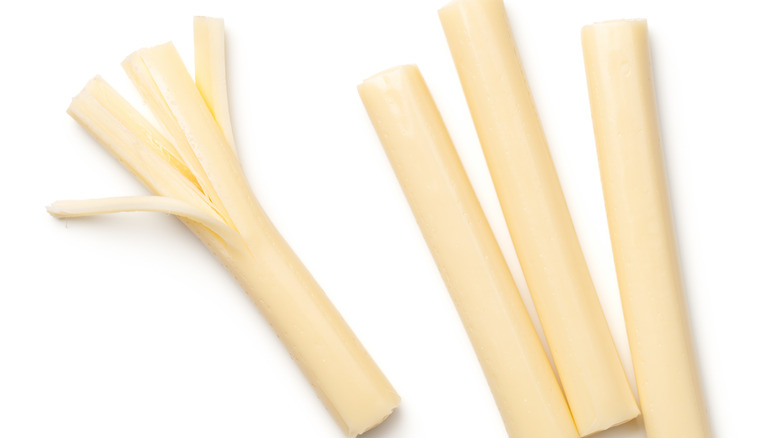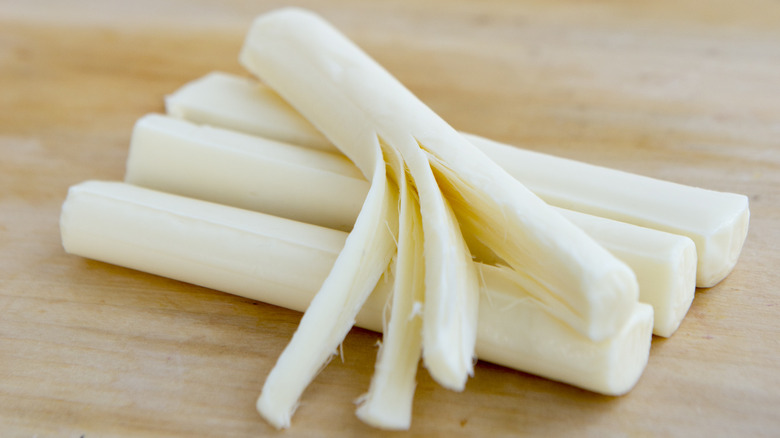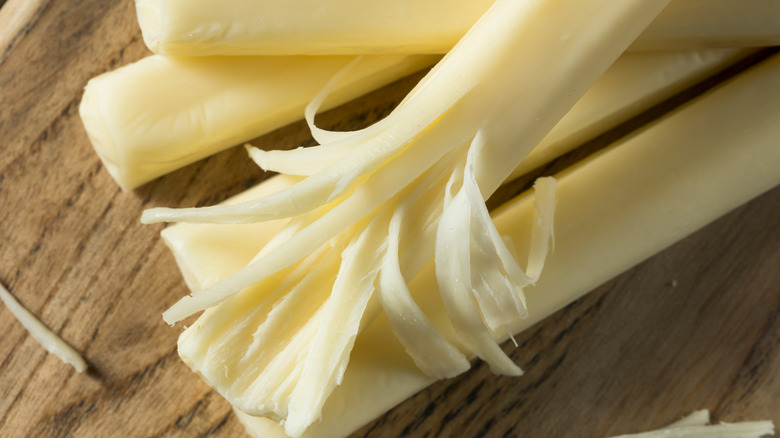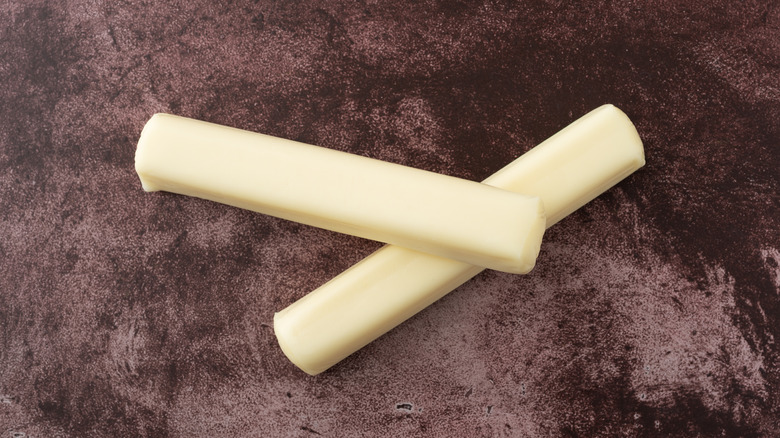This Might Have Been Where Mozzarella String Cheese Began In The US
An indelible childhood staple and a "national craze" (per The Atlantic), string cheese is a reliable snack standby that has resulted in many a debate about its origins and the proper way to eat it: Whether to "pull strings" — or segments of cheese — or to take bites of it whole. As evidenced by this Utah State University study titled "The Structure and Rheology of String Cheese," the food is obviously a hotly contested topic.
National Today delves into the reason behind what makes string cheese, well, stringy. "When heated up to 140F and stretched, the milk protein in mozzarella line up, making it possible to peel strips or 'strings' from the main block of cheese," the publication notes. Of course, they are also sometimes used to make mozzarella sticks, according to U.S. Dairy.
But where did string cheese come from? What caused this fun and easy-to-eat snack to be invented in the first place?
String cheese has many potential origins
Although many companies now make string cheese, its origins are debated. Lapham's Quarterly reports it stems from a 14-year-old girl in 19th century Mexico named Leobarda Castellanos Garcia, Cooking Chew points to braided 'string' cheese which has been enjoyed for centuries, while others claim that Baker Cheese company was the first to truly market the product. In addition, Culture Cheese Mag writes about Armenian string cheese. But Snack Stack notes that the food has "countless variations and no single origin story." Cooking Chew reports even more potential string cheese origins, such as Slovakian, Armenian, or Mexican string cheeses, which are sometimes seasoned and braided.
According to the in-depth piece in The Atlantic, string cheese was invented by Baker Cheese, based in Wisconsin, which began selling cheddar cheese in 1916. The story states that the 1950s changed America's relationship to cheese, when the introduction of pizza to American travelers and soldiers returning from Italy after World War II created a booming demand for mozzarella. Baker Cheese then began to focus on mozzarella and would sell "six-pound loaves or 20-pound blocks of cheese" to restaurants and pizzerias, before receiving requests for "smaller units" that customers could easily eat as a snack, as opposed to a pizza topping.
How American string cheese began to boom in popularity
Switching from cheddar to mozzarella proved to be a wise move, but coming up with an idea to satiate the need for a "cheese snack" is what truly put Baker Cheese above and beyond. So instead of shaping the cheese into a block or square, The Atlantic continues, Frank Baker contemplated chopping it into strips. He began to "hand stretch them and roll them up and cut them into ropes ... soak them in the salt brine ... and he realized by doing it this way, cheese would have 'stringing' characteristics," Frank's grandson told the magazine.
Baker Cheese first had local bar patrons try it as a snack in the 1970s, but eventually, the cheese became popular with kids when the company began wrapping the sticks individually. This extended the product's shelf life, as well as helped parents quickly stuff a single serving into a child's lunch box, or grab one as they headed out the door. The Green Bay Gazette notes that the individually-wrapped sticks boomed in popularity in the '80s, and by the '90s, "string cheese was about 50 percent of [Baker's Cheese] production."
String cheese might have also began in Mexico
As previously stated, another string cheese origin theory revolves around Leobarda Castellanos Garcia, a 14-year-old girl living in Mexico in 1885. The Tennessee Tribune lays out the legend that she invented quesillo, which Cheese.com also refers to as "Oaxacan style string cheese." It's made of strings before being shaped into a ball, has a melty texture and mild taste similar to American string cheese, and is popular in quesadillas, enchiladas, and sandwiches.
According to Lapham's Quarterly, Garcia intended to make a queso fresco, but inadvertently made a "gummy" cheese. Her parents then realized that the end result was not problematic, and after some tweaking, created a new product that utilized different "curdle times and temperatures" in creating a cheese that's very different from quesco fresco, but delicious all the same.
No matter the origins — and however you prefer to eat it — string cheese has stood the test of time.



